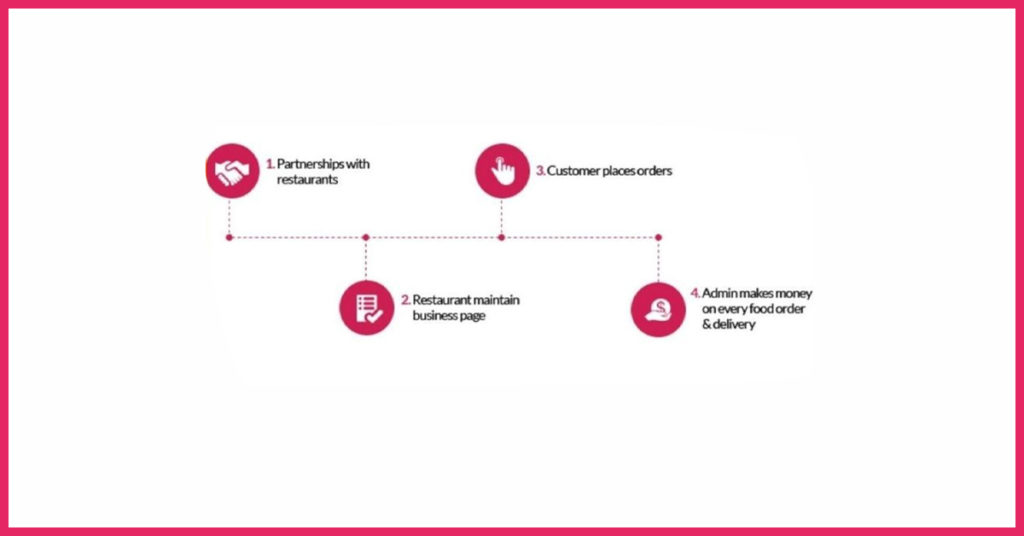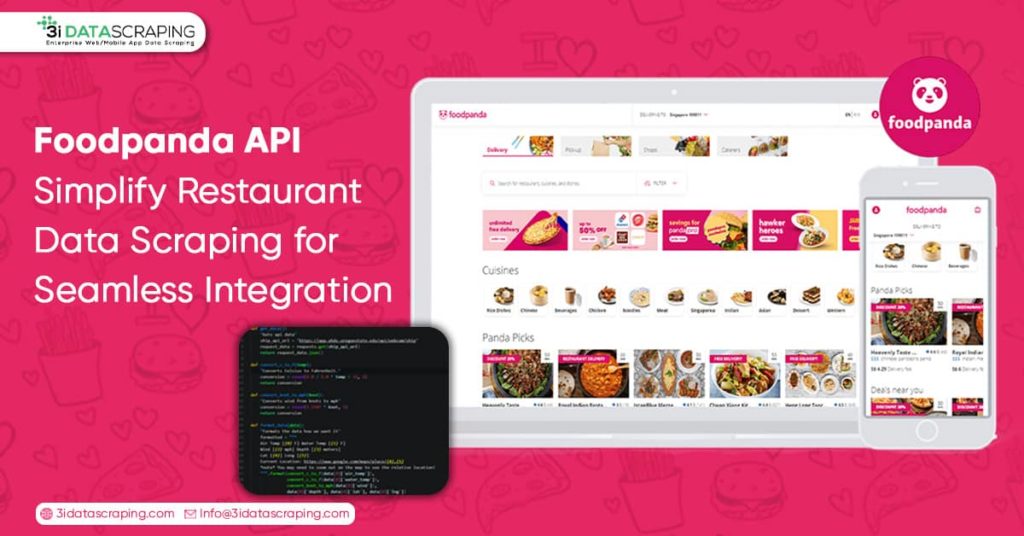Foodpanda API: Simplify Restaurant Data Scraping for Seamless Integration
- July 17, 2023
Our achievements in the field of business digital transformation.









Introduction
In today’s hospitality and food industries, data extraction from restaurants has taken the world by surprise. To stay in business and stand out, restaurant owners and entrepreneurs scrape data from their competitors’ recipes to create new menus and exclusive deals. Competitive pricing and strategic data scraping can help you learn the ins and outs of the industry and find unexplored possibilities in the sector’s nooks and crannies. In this blog, we’ll look at everything you need to know about scraping the FoodPanda API and business listing data from A to Z.
Overview of FoodPanda API

With over 10 million users, FoodPanda is one of the biggest online marketplaces for delivering or picking up food. The app works in more than 400 places and has more than 115,000 restaurants in its database. So, hundreds of thousands of people use FoodPanda daily to find somewhere to eat. Many people who go to restaurants often and love food also share their pictures and write helpful reviews on FoodPanda.
So, the site is a collection of high-quality food files that can be used by any business related to food. With the FoodPanda API and data scraping, you can extract well-organized and compiled restaurant data from various websites online. This can do wonders for your restaurant business.
The most basic list of data fields that you can get from the FoodPanda API is as follows:
- Restaurant’s ID
- Restaurant’s Name
- Address
- State
- City
- Country Code
- Postal Code
- Cost
- Aggregate Ratings
- Highlights
- Email Id
- Cuisines
- Latitude
- Longitude
- Opening Hours
- Menu
- Price Range
- Phone
- Review
- Website
- Votes
Importance of Data in the Foodpanda Ecosystem
FoodPanda is an app that lets people get hot meals delivered to their door. So, it uses GIS, location technology, and maps to do something impressive. FoodPanda’s leading partners in terms of mapping and position are Open Street Map and Google. FoodPanda uses the customer’s geo-location because every restaurant or eatery has a transport polygon. They use geo-reference to determine where the restaurant is and where it can serve within a three- to ten-mile radius. So, location intelligence is critical to the growth and usefulness of FoodPanda.
Location technology is helpful for food delivery businesses in more ways than just for geo-referencing. Location intelligence, for example, can be used carefully to get more valuable and actionable information. One everyday use case is getting information about a customer to determine what kinds of food are available, where the gaps are, when the places open and close, how far away they are, and so on. FoodPanda uses all this information to do a demographic study showing the cuisine gap. This can be used to get more restaurants in an area where a customer lives.
FoodPanda uses new technologies like AI, Big Data, and Machine Learning to exceed customers’ expectations. It also uses location intelligence and tracking data. In the same way, Data Science and Machine Learning have been used strategically and thoughtfully to help FoodPanda serve hot meals in most markets in less than 20 minutes. Together, these two technologies can make exact predictions about the best route, rider, and restaurant near where the customer is.
Understanding Foodpanda Data Sets
Now that we know what FoodPanda is and how it works let’s look into its data sets more deeply.
- Region-wise FoodPanda Data
By extracting FoodPanda data by area, it’s possible to get data, information, and files that can be used in restaurant food and cuisine. You can also get specific ideas about how to come up with and make different menus, etc.
- Scraping Restaurant Menu Data
If you scrape the correct information from a FoodPanda restaurant’s offering, you can use that information for different business needs. They can help you make your business friendlier to customers.
- FoodPanda Competitive Pricing Men
It is also possible to scrape FoodPanda data, such as the food’s price, the food’s name, the menu, and other important information for a business. The process can help protect site IPs from being banned, set menu estimates, and eliminate data used more than once.
- Item-wise Service, Delivery Charges, Packaging, Discounts, etc
FoodPanda data extraction also lets you get information about sale prices, shipping costs, packing, etc. You can get sensitive and very correct information.
- Competitive Pricing Data
By scraping pricing data from FoodPanda, you can improve customer value and market reach, figure out the cheapest way to get new customers, reduce risks, and make well-informed choices.
- Mobile App Data from FoodPanda
FoodPanda is a new way to get hot food to people. So, many restaurants use the FoodPanda app to make it easier for customers to buy food. You can find food service apps that work like regular platforms between the food and the customers. The process can help turn things around quickly and gather resources for growing up. So, by pulling data from the FoodPanda app’s delivery parts, it is possible to get accurate and timely deliveries.
- Graphical User Interface of Food Delivery Data
Every food distributor, including FoodPanda, has a Graphical User Interface. With GUI data scraping, you can get helpful information from places like the Home Screen, Order History, Search and Filter, Orders Placed, Marketing Properties, Delivery maps, etc.
Real-World Applications of Foodpanda Data Sets
Some of the ways FoodPanda Data Sets can be used in the real world are:
- Digitization of the Restaurant Menu
Menu digitizing is the process of making changes to meals with a computer. Several restaurants scrape data from food platforms like FoodPanda to create a digital menu that helps their business run more smoothly.
- More Budget for Main Activities
By scraping and extracting data from FoodPanda, it is possible to save money, improve the marketing and sales process, and use the money for more important goals and needs
- Price Optimization
Price optimization is an excellent example of how FoodPanda data scraping can be put to use. Reviewing the prices at your restaurant is easier if you think about what people are willing to pay. You can get customer information from FoodPanda and meet their needs by changing how you price and promote your business.
- Lead Generation
Lead creation is another big reason to scrape data from the FoodPanda API. You can quickly find the websites of relevant restaurants and then figure out who your target market is.
- Sentiment Scrutiny
Sentiment analysis is figuring out how a text, like a review or a statement, makes the reader feel (positive, negative, or neutral). So, one of the best ways to use FoodPanda data scraping in real life is to find feedback-related data and use it for a study.
- Brand Monitoring
Customers are likelier to choose your restaurant over others if your online presence is clear and reasonable. So, one of the essential real-world uses of FoodPanda Data Extraction is to learn more about what customers think and raise company awareness.
Conclusion
So, there you have it: a quick look at the FoodPanda API and scraping restaurant data. In the coming years, proper data scraping methods will be essential for a restaurant business to stay alive and do well.














What Will We Do Next?
- Our representative will contact you within 24 hours.
- We will collect all the necessary requirements from you.
- The team of analysts and developers will prepare estimation.
- We keep confidentiality with all our clients by signing NDA.





